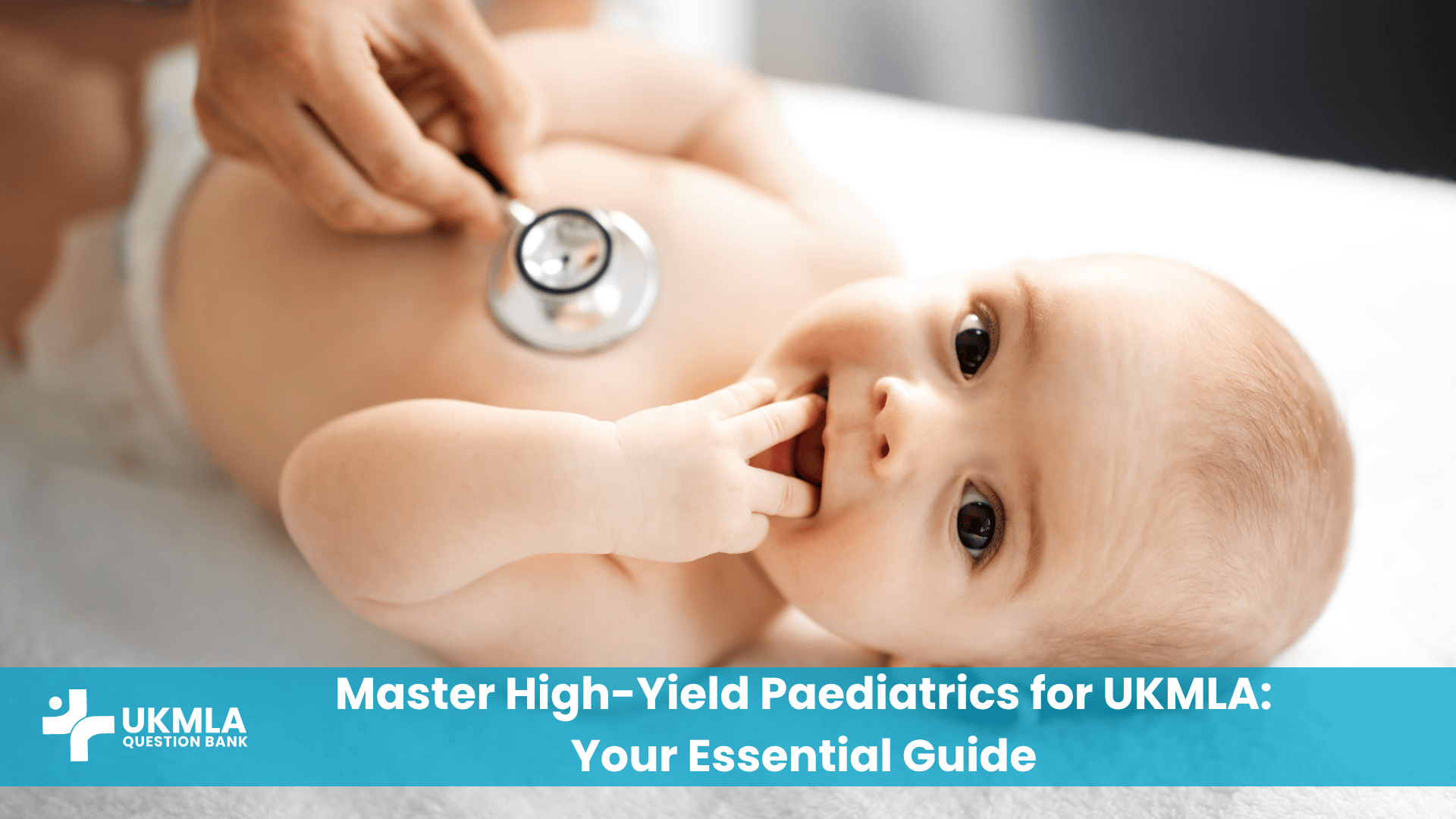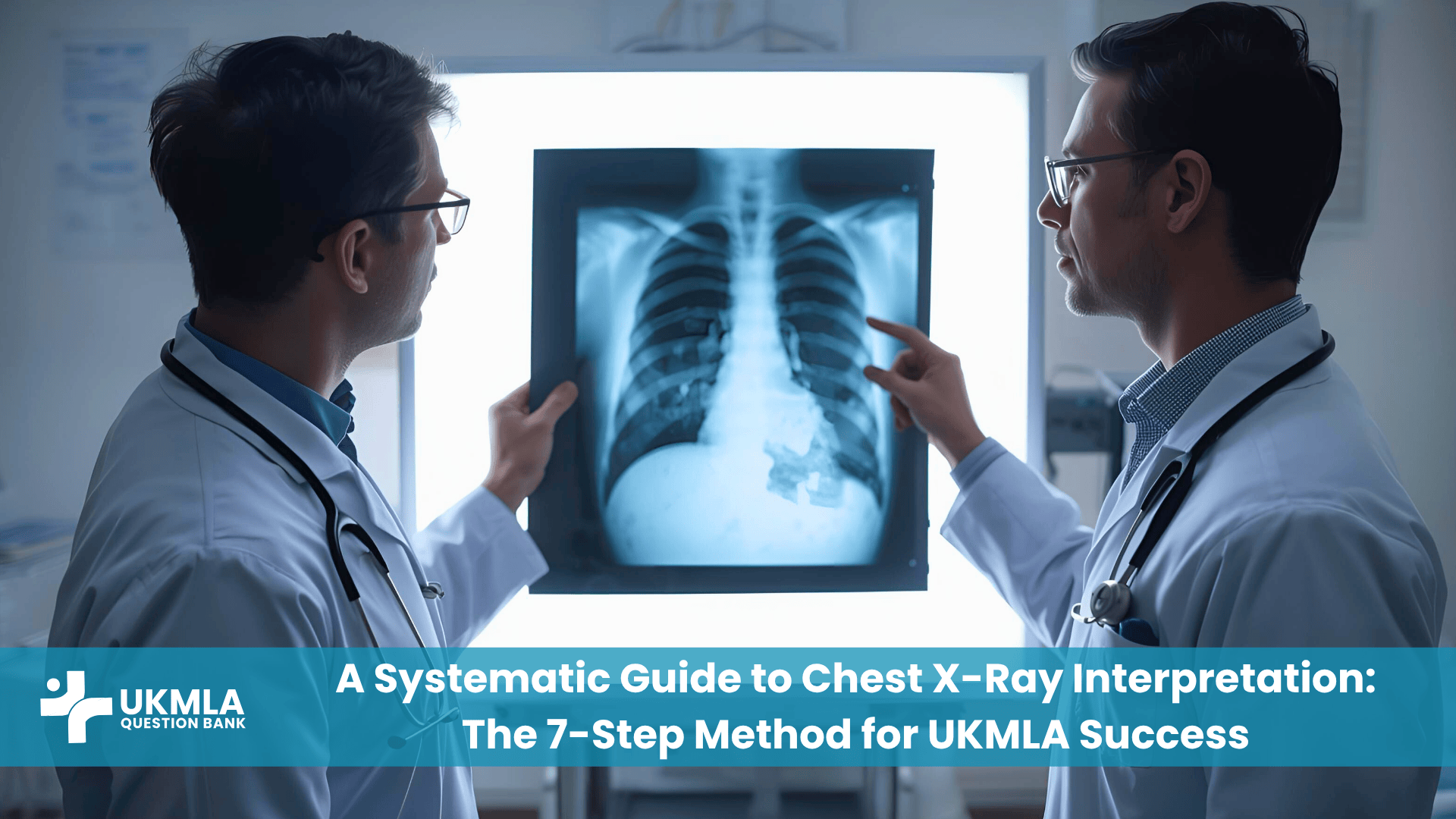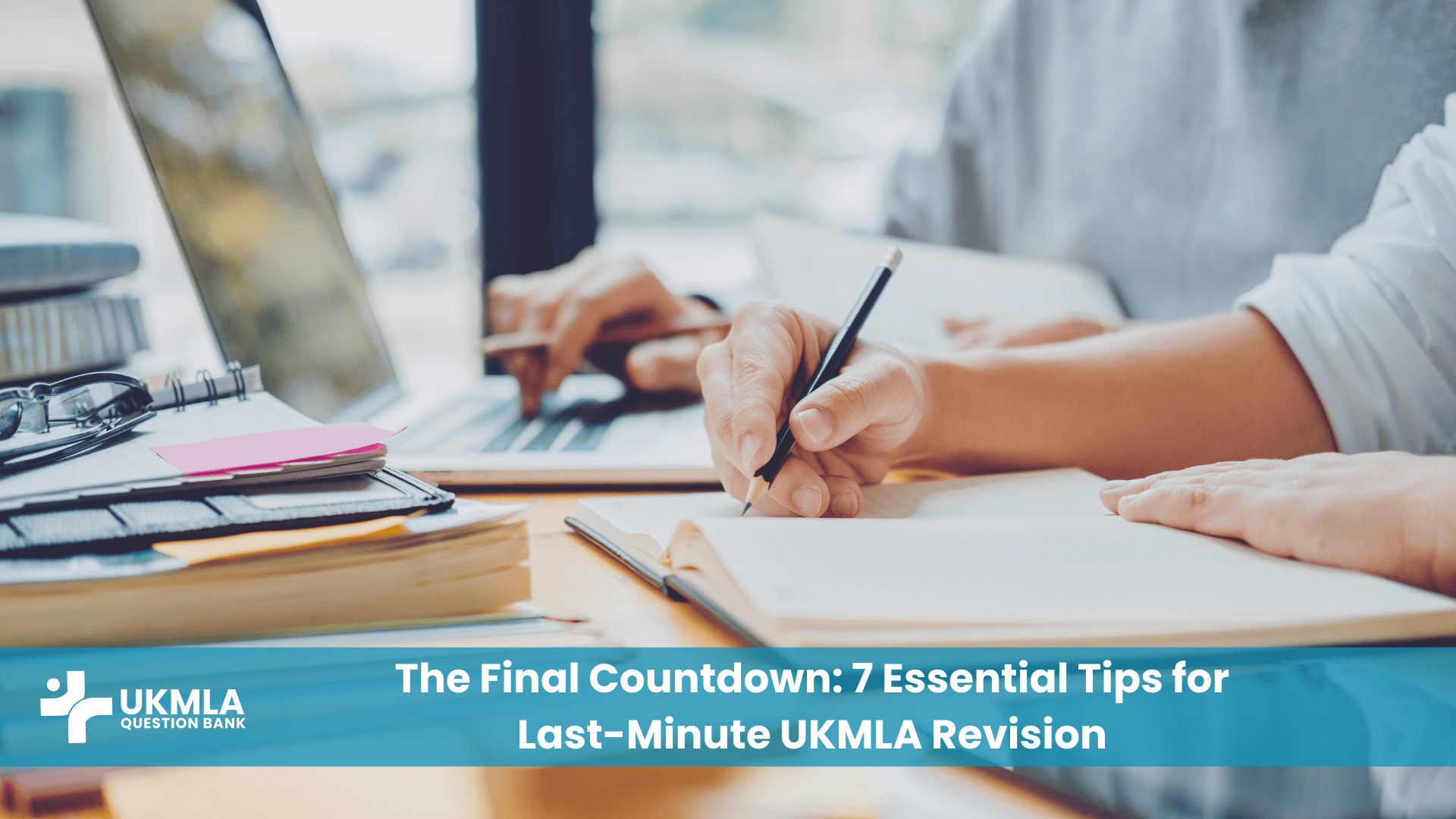Introduction
Mastering high-yield paediatrics for UKMLA is a unique and critical challenge for every medical student. Paediatrics is far more than just adult medicine in miniature; it is a distinct field with its own complex physiology, unique pathologies, and rapidly changing clinical signs. The ability to assess a child, interpret developmental milestones, and recognise the subtle signs of serious illness is a core competency for any doctor, making this a cornerstone of the UK Medical Licensing Assessment (UKMLA).
This guide is designed to be your essential roadmap. We will cut through the vast curriculum to focus on the key conditions, management principles, and crucial red flags that are most likely to appear on your exam. From the acutely unwell child to safeguarding principles, this is your high-yield guide to success.
Key Takeaways
Structure Your Revision Around the 5 Pillars: Focus your study on the five core areas: Growth & Development, Paediatric Emergencies, Common Presentations, Neonatology, and Safeguarding, as these form the foundation of the curriculum.
Master the “Acutely Unwell Child” Approach: Prioritise learning to systematically assess a sick child (using ABCDE and the Paediatric Assessment Triangle) and manage key emergencies like sepsis, meningitis, and anaphylaxis. Remember that tachycardia is a more reliable early sign of shock than hypotension.
Know Your Developmental Milestones: Your ability to identify normal development versus a “red flag”—such as missed milestones or developmental regression—is fundamental to all paediatric assessments and a frequently tested topic.
Safeguarding Is a Core Professional Duty: Be vigilant for the signs of non-accidental injury (NAI), understand the different categories of abuse, and know your professional and legal duty to escalate any concerns. This is a critical aspect of your fitness to practise.
Move Beyond Memorisation to Active Practice: Paediatrics requires an integrated understanding of multiple systems. The most effective way to prepare is to use practice questions to actively apply your knowledge to clinical scenarios, mimicking the style of the UKMLA.
The Core Pillars of High-Yield Paediatrics for UKMLA
To build a strong foundation in high-yield paediatrics for UKMLA, it’s best to structure your revision around five core pillars. Mastering these areas will ensure you have a comprehensive grasp of what’s expected.
1: Growth & Development
Understanding what is normal is the first step to recognising the abnormal. This pillar is foundational to all of paediatrics.
Developmental Milestones: You must be familiar with the key milestones across four domains: gross motor, fine motor & vision, speech & language, and social & emotional. Know the ages for key events like sitting unsupported (6-7 months), pincer grip (9-12 months), first words (12 months), and combining words (18-24 months). A missed milestone is a red flag that requires further investigation. Crucially, you must recognise developmental regression—the loss of previously acquired skills—as a major red flag that requires urgent neurological assessment.
Growth Charts: Be comfortable plotting and interpreting UK-WHO growth charts. Understand the significance of crossing centiles (upwards or downwards), which can indicate failure to thrive, chronic illness, or endocrine abnormalities. A drop across two or more centiles is a significant indicator of “failure to thrive” and warrants investigation.
Puberty: Know the sequence of pubertal development in both boys and girls. Be able to identify precocious puberty (onset before 8 in girls, 9 in boys) and delayed puberty (no signs by 13 in girls, 14 in boys), as these are common SBA (Single Best Answer) scenarios that test your knowledge of underlying endocrine pathology.
2: The Acutely Unwell Child (Paediatric Emergencies)
Recognising and initiating management for a sick child is a high-stakes skill and a priority for the GMC (General Medical Council). Always start with a systematic ABCDE approach.
Clinical Pearl: “A child’s physiology can compensate brilliantly for illness, until it suddenly collapses. Tachycardia and tachypnoea are early, vital signs of distress. Hypotension is a late and ominous sign. Never be falsely reassured by a normal blood pressure in a child who looks unwell.”
The Paediatric Assessment Triangle (PAT): This is a rapid “look, listen, feel” tool to form a general impression of the child in seconds. It assesses:
Appearance: Tone, interactiveness, consolability, look/gaze, speech/cry.
Work of Breathing: Abnormal sounds (stridor, wheeze, grunting), abnormal positioning, retractions, nasal flaring.
Circulation to Skin: Pallor, mottling, cyanosis.
Fever in Under 5s: This is a classic presentation. Your job is to differentiate the vast majority with simple viral illnesses from the few with life-threatening bacterial infections. You must know the “traffic light” system for risk stratification. For an authoritative overview, the NICE guideline (NG143) on ‘Fever in under 5s’ is an essential resource.
Sepsis & Meningitis: Be able to recognise the signs of sepsis (fever or hypothermia, tachycardia, altered mental state, prolonged capillary refill time) and meningococcal disease (non-blanching rash, neck stiffness, photophobia). Early recognition, obtaining blood cultures, and rapid administration of IV antibiotics and fluid resuscitation are critical, life-saving steps.
Acute Asthma Attack: Know the stepwise management for an acute exacerbation. This includes high-flow oxygen, salbutamol nebulisers (often back-to-back initially), ipratropium bromide for moderate-to-severe cases, and early administration of oral or IV steroids (prednisolone or hydrocortisone).
Anaphylaxis & DKA: Know the immediate management for anaphylaxis (IM adrenaline) and the core principles of managing Diabetic Ketoacidosis in children, which involves a carefully controlled infusion of intravenous fluids and a fixed-rate insulin infusion.
3: Common Paediatric Presentations
This pillar covers the bread-and-butter conditions that frequently appear as UKMLA stations, organised by system.
Table 1: Common High-Yield Paediatric Presentations by System
| System | Key Conditions & Differentiating Features |
|---|---|
| Respiratory | Croup: Barking cough, stridor. Caused by parainfluenza virus. Bronchiolitis: Wheeze/crackles in <1yr olds, coryzal prodrome. Caused by RSV. Viral-Induced Wheeze: Wheeze in older toddlers, often recurrent. Pneumonia: Focal crackles, fever, may have chest pain. |
| Gastrointestinal | Gastroenteritis: Know signs of dehydration (reduced urine output, sunken eyes). Pyloric Stenosis: Projectile vomiting in a hungry neonate. Intussusception: Redcurrant jelly stool, colicky abdominal pain. Chronic Constipation: A common issue; understand management principles like diet, fluids, and laxatives (e.g., macrogols). |
| Neurology | Febrile Convulsions: Common, usually benign seizures with fever. Differentiate simple vs. complex. Absence Seizures: Brief episodes of “staring into space.” |
| Musculoskeletal | The Limping Child: Differentiate Transient Synovitis (afebrile, well child, recent viral illness) from Septic Arthritis (febrile, unwell, non-weight-bearing). |
| Rashes | Measles: Koplik spots, rash descends from the face. Slapped Cheek Syndrome: Caused by Parvovirus B19. Hand, Foot & Mouth: Caused by Coxsackie A virus. |
4: Neonatology Essentials
The first 28 days of life present unique challenges that are heavily tested.
Neonatal Jaundice: You must be able to differentiate between benign physiological jaundice (appears after 24 hours, resolves quickly) and pathological jaundice (appears within 24 hours, rapidly rising bilirubin), which requires urgent investigation for causes like haemolysis or biliary atresia.
Neonatal Resuscitation: Understand the Apgar score and the basic algorithm for neonatal resuscitation, focusing on warmth, airway, breathing, and circulation.
Respiratory Distress Syndrome (RDS): Primarily affects premature infants due to surfactant deficiency. Presents with tachypnoea, grunting, and intercostal retractions.
Neonatal Sepsis: Know the risk factors (e.g., maternal Group B Strep, prolonged rupture of membranes). Differentiate early-onset (<72 hours), often from maternal transmission, from late-onset (>72 hours), which is often from environmental sources. The presentation can be non-specific (e.g., poor feeding, lethargy, temperature instability).
Neonatal Hypoglycaemia: Be aware of at-risk infants (e.g., those born to diabetic mothers, premature, or small for gestational age) and the need for regular blood glucose monitoring.
5: Safeguarding & Child Health Promotion
This pillar focuses on the doctor’s wider role in protecting children and promoting health. Understanding these principles is a key demonstration of the professionalism and trustworthiness required of any doctor.
Safeguarding/Non-Accidental Injury (NAI): Be vigilant for signs of NAI. This includes inconsistent or changing histories, delayed presentation, and specific injury patterns (e.g., spiral fractures from twisting, cigarette burns, subdural haematomas). You must understand the different categories of abuse: physical, emotional, sexual, and neglect. A doctor’s professional and legal duty is to document concerns meticulously and discuss them with a senior colleague or the named safeguarding lead.
Childhood Immunisations: While you don’t need to memorise every detail, you should be familiar with the official UK childhood immunisation schedule in principle. Know which are live vaccines (e.g., MMR, BCG, nasal flu) as this has implications for immunocompromised patients, and be able to address common parental concerns with empathy and factual information.
Structuring Your Paediatrics Revision for the UKMLA
Knowing the content is only half the battle. A structured approach to revision is key.
Integrate Your Learning: Paediatrics is not an island. A child with a limp could be orthopaedics (DDH), rheumatology (juvenile idiopathic arthritis), or even oncology (leukaemia). Link your learning across specialties to build a robust differential diagnosis for any presentation.
Master Paediatric History Taking: Taking a history from a parent while observing the child is a unique skill. Your framework must include: presenting complaint, birth history (pregnancy, delivery, neonatal period), developmental history, immunisations, feeding and growth history, and a detailed social history (including who is at home and any safeguarding concerns).
Use Question Banks Effectively: The best way to prepare for the style of UKMLA questions is to practice them. Using a dedicated UKMLA Question Bank allows you to apply your knowledge in a timed, exam-like setting and to identify and remedy your weak spots.
Final Piece of Advice: “When in doubt, always refer back to the basics: Airway, Breathing, Circulation, Disability, Exposure (ABCDE). This systematic approach will keep your patient—and your exam performance—safe.”
Frequently Asked Questions (FAQ): High-Yield Paediatrics for UKMLA
Don’t try to memorise a random list. Group them logically by age (e.g., what to expect at 6 months, 1 year, 2 years) and by domain (gross motor, fine motor, etc.). Use mnemonics and practice with questions that present a child’s age and ask if a certain skill is expected or if a red flag is present.
The UKMLA will test your ability to prescribe safely. This includes being able to calculate doses based on weight (e.g., mg/kg) using the information provided. You will be expected to know common paediatric drug dosages for emergency situations, such as for paracetamol, ibuprofen, and antibiotics. Practice is essential to build speed and accuracy.
Focus on rashes that indicate serious illness (e.g., the non-blanching purpuric rash of meningococcal disease) and the classic childhood exanthems (measles, slapped cheek, hand-foot-and-mouth, chickenpox, scarlet fever). Be able to describe the rash, its distribution, and any associated prodromal symptoms.
It’s tested through clinical scenarios. A question might describe a child with an injury and an inconsistent or implausible history from the parents. The correct answer will involve recognising the discrepancy as a red flag and choosing the appropriate next step (e.g., “discuss with a senior colleague” or “follow local child protection procedures”), not confronting the parents.
You should have a working understanding of the principles of Gillick competence and Fraser guidelines, which relate to a child’s capacity to consent to their own medical treatment, sometimes without parental knowledge or consent, provided they are deemed to have sufficient understanding.
Use a systematic approach based on age and clinical features. In any child, first rule out the emergency: septic arthritis (febrile, unwell, non-weight-bearing). Then consider common causes by age: in toddlers, transient synovitis is common. In older children, think about Perthes’ disease or SUFE. Always consider leukaemia as a rare but important differential.
You don’t need to know the exact date for every single vaccine. Instead, understand the key time points (e.g., the primary course at 8, 12, 16 weeks, and key boosters at 1 year and 3 years 4 months). Most importantly, know which are live vaccines (e.g., MMR, BCG, nasal flu) as this has implications for immunocompromised patients and their families.
Recognising compensated shock. Children can maintain a normal blood pressure for a long time despite being very sick. Therefore, you must rely on earlier signs like tachycardia, tachypnoea, cool peripheries, and prolonged capillary refill time to identify the unwell child before they decompensate.
This tests the “Interpersonal Skills” and “Professionalism” domains. The key is to acknowledge their concern ("I can see you're very worried"), listen actively to their specific fears, explain your thoughts and plans clearly and without jargon, and provide a clear plan and safety net advice ("If X, Y, or Z happens, you must come straight back").
The GMC’s UKMLA Content Map is your ultimate syllabus. Use it to ensure your revision covers all the required patient presentations and conditions. The “high-yield” topics in this guide are those that appear most frequently and are deemed most critical within that official framework.
Conclusion & Call to Action (CTA)
Conquering the high-yield paediatrics for UKMLA is about more than just memorising diseases. It’s about developing a clinical mindset that prioritises development, recognises emergencies, and always considers the child within their family and social context. By structuring your revision around the five core pillars—Development, Emergencies, Common Presentations, Neonatology, and Safeguarding—you build a robust framework for success.
Remember to think like a safe junior doctor at all times. Use systematic approaches like ABCDE, know your red flags, and never underestimate the value of a parent’s concern. With focused preparation and active practice, you can master this challenging but rewarding subject.
Ready to apply your knowledge and test yourself against realistic, UKMLA-style paediatric scenarios? Explore the comprehensive question bank and turn your high-yield revision into a high-scoring performance.




